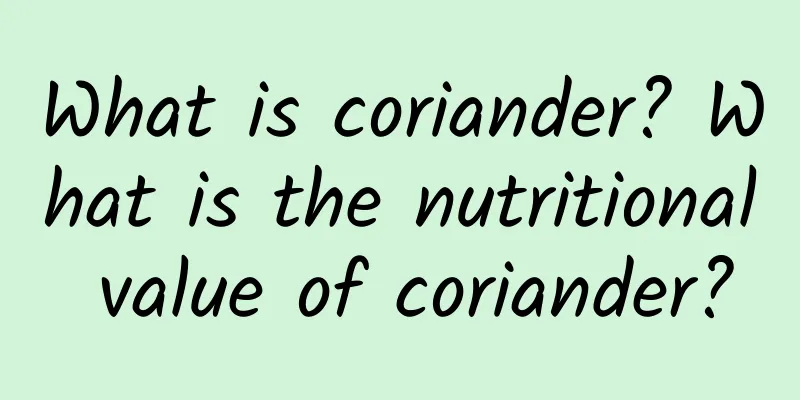What is coriander? What is the nutritional value of coriander?

|
Coriander is an important spice vegetable, refreshing and appetizing, and can be added to soup. The stems and leaves are used as vegetables and spices, and have the effect of strengthening the stomach and digestion; the stems are cylindrical, upright, multi-branched, striped, and usually smooth. The amount of vitamin C contained in coriander is much higher than that of ordinary vegetables. Coriander has a strong taste. People who like to eat it like it very much, and those who don't like it will not even smell it. Which category are you in? Contents of this article 1. What is coriander? 2. What is the nutritional value of coriander? 3. How to eat coriander 1What is coriander?Coriander, formerly known as coriander, alias: coriander, coriander, Latin name: Coriandrum sativum L. It is an annual or biennial herb with a strong smell, belonging to the Apiaceae family and the genus Coriander, 20-100 cm high. The root is fusiform, slender, with many slender lateral roots. The stem is cylindrical, erect, multi-branched, striped, and usually smooth. The basal leaves are petiolate, the style is erect when young, and recurves outward when the fruit is ripe. The fruit is spherical, with obvious main ridges and adjacent secondary ridges on the back. The ventral surface of the endosperm is concave. The oil tube is not obvious, or there is one located below the secondary ridge. It is native to the Mediterranean region of Europe and is cultivated in Northeast my country, Hebei, Shandong, Anhui, Jiangsu, Zhejiang, Jiangxi, Hunan, Guangdong, Guangxi, Shaanxi, Sichuan, Guizhou, Yunnan, Tibet and other provinces and regions. The stems and leaves are used as vegetables and spices, and have the effect of strengthening the stomach and helping food; the fruits can be used to extract aromatic oils; the fruits are used as medicine, and have the effects of dispelling wind, clearing rashes, strengthening the stomach, and removing phlegm. 2What is the nutritional value of coriander?1. The tender stems of coriander contain volatile oils such as mannitol. 2. The carotene content in coriander is more than 10 times higher than that in tomatoes, green beans, cucumbers, etc. 3. The amount of vitamin C contained in coriander is much higher than that in ordinary vegetables. Generally, 7 to 10 grams of coriander leaves can meet the body's demand for vitamin C. 4. Coriander is rich in nutrients and has a high water content of up to 90%. Coriander contains vitamin C, carotene, vitamin B1, B2, etc. It also contains rich minerals such as calcium, iron, phosphorus, magnesium, etc. Coriander also contains potassium malate, etc. 3How to eat coriander1. Coriander is an important spice vegetable, refreshing and appetizing, and can be added to soup. In addition, coriander contains essential oils and has a strong pungent taste. Do not make juice alone for drinking. You can mix it with other fruits to make juice for drinking, but do not exceed 30 grams each time. 2. Do not eat rotten or yellowed coriander, because it has lost its aroma and has no effect as mentioned above. It may also produce toxins, which may cause nervous organ disorders. |
<<: Avoid the sun, work hard to live... Post-80s people living under the shadow of hepatitis B
>>: Oh my god, I was burned by a 40℃ hand warmer...
Recommend
Why is there thick blood clots in menstruation?
Menstruation is a physiological phenomenon unique...
What is the reason why women’s vagina is loose?
Vaginal relaxation is a very common phenomenon in...
What fruits are not suitable to eat during menstruation?
Menstruation is a very important stage for women....
What are the characteristics of mud shrimp? Nutritional analysis of mud shrimp
Some people don't like to cook and eat shrimp...
Picture of small polyps in baby girl's anus
Key reminder: There are many reasons why a girl h...
How is Sichuan hotpot soup base? How to eat Sichuan hotpot soup base?
Beef and sauerkraut hotpot is a delicacy. The ing...
Prepare for the college entrance examination and relax about food, clothing, housing and transportation
It is graduation season again. For the students w...
How to treat chills and coldness after childbirth
Many pregnant mothers easily develop some health ...
The certainty of teratogenicity of CT in early pregnancy
There are many things that women need to pay atte...
What are the causes of menstrual disorders in women?
Irregular menstruation is a common gynecological ...
Will women with kidney deficiency have miscarriage? What Parenting Experts Say
Kidney deficiency can cause great harm to women. ...
What are the precautions during menstruation?
There are many issues that women need to pay atte...
I feel sleepy right after eating! Who says carbon monoxide poisoning is not a kind of tipsiness?
After a big meal, you feel sleepy Lying in bed an...









